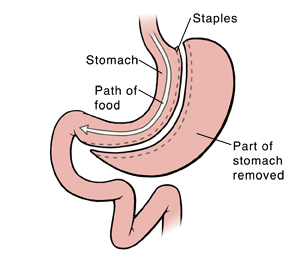Bariatric Surgery: Vertical Sleeve Gastrectomy
Bariatric surgery is a procedure that helps you lose weight. In vertical sleeve gastrectomy, surgery is done only on the stomach. The small bowel is not affected. This surgery removes about 80% of the stomach. The part of the stomach that is removed is the part that normally stretches out a lot when you eat. The amount of the stomach that is left is shaped like a narrow sleeve. It is shaped a bit like a banana. This sleeve does not stretch very much. It can hold only a few tablespoons of food. Food then passes slowly through a narrow opening at the bottom of the stomach. This opening is called the pyloric valve. Food empties out like it did before surgery. This procedure also causes changes in hormones that affect appetite.

The procedure
This surgery can be done in one of two ways:
-
Laparoscopic surgery. Small incisions are made in your upper belly. A tube with a tiny camera that sends images to a video screen is put into one of these incisions. Small surgery tools are put into the other small incisions. The surgeon works by looking at the organs on the video screen. Almost all sleeve gastrectomy surgery is now done this way.
-
Open surgery. This is also called laparotomy. One larger incision is made in the middle of the upper belly. The surgeon sees and works through this incision. Most cases are not done this way now. This is because the laparoscopic way uses smaller cuts. It causes less harm to tissues and fewer problems.
During the surgery, the stomach is cut lengthwise (up and down) with a tool that staples as it cuts. The larger part of the stomach is removed. The side of the remaining stomach (the sleeve) is closed off with staples made from stainless steel or titanium.
Preventing gallstones
Bariatric surgery is done to cause a large amount of weight loss. Weight loss can cause gallstones. If you already have gallstones, your gallbladder may be removed during your surgery. Or it may be removed at a later date. This is to prevent gallstones from forming.
All types of bariatric surgery have different advantages and disadvantages. Be sure to discuss the risks and complications of this surgery and any other choices with your doctor.
© 2000-2025 The StayWell Company, LLC. All rights reserved. This information is not intended as a substitute for professional medical care. Always follow your healthcare professional's instructions.